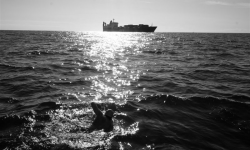08 Aug 2013Plons Channel Team swims the EC

The Dutch Plons Channel Team swim to France in 11 hours and 56 minutes
Plons Channel Team swims the EC
Let me introduce us first. Plons is a Master swim club with a gay signature. We stand for “Swimming for Gays, Lesbians and Friends”. We are the oldest gay swim team in our country and have just celebrated our 20th anniversary. Myself (Richard) I have a history of competitive open water swimming dating from 1974. The swimmers saw that I coached several teams successfully across the English Channel (of which one world record - the ladies relay double in 2012). They asked me if they could swim the Channel with me as swimmer and/or coach. The drive was there and I expected most had swimming speed enough. So we set out for an adventure that lasted two years including preparation.
Next to the sporting challenge the team added a social challenge: collecting as much money as possible for KiKa (that is the Dutch fund for prevention of Children’s Cancer).
We started out with a several swimmers more, however, some had to drop out for personal reasons. The eventual team existed of 7 members. The mixed character of the Channel team was representative of the whole club: 5 were gay 2 were not, 6 men and 1 woman.
What did we do to prepare?
- Learn to swim in open water. The Netherlands has plenty of that! Most team members did not have any open water experience.
- Train in the sea. Our city has beaches on the North Sea.
- Learn to swim next to a boat. We swam the IJsselmeer with an experienced pilot from the IJsselmeer Swim Marathon organization. The practice was also a first for practicing our routine of preparing to swim, swimming, getting out and warming up, providing safety and coaching for the swimmer. We also practiced being in close quarters for the period we swam and travelled to the start.
- Acclimatize to colder water. Was regular pool swimmers we train in 27-30C. The sea is nice and invigorating! We kept swimming in October when the water was getting colder to get used to chillier conditions. We also started swimming in open water early this season. As soon as the water was 14C we went out to train. OK, the first times it was quite short for some of us.
- Learn to swim at night. None of the other members had any night swimming experience other than a skinny dip.
- The 2 hour test proved to be difficult. The first time we tried in an outdoor pool that was not open yet. The water was being heated. But just under 14C. No way! The second time we swam in an outdoor pool too. The weather was nasty and the wind cooled the swimmers too fast to end the 2 hours successfully. They did have the experience they needed to swim the 2 hours at under 16C when weather is not too terrible. The outdoor pools were no longer possible for they were heated up for public swimming. We swam in a small lake and each of us were successful at first attempt in open water. I think it is more fun to swim 2 hours in open water. They were all proud of their accomplishments.
- Keeping speed for an hour. The Plons Channel Team swimmers are very much used to interval training, but not to longer distances. We had some hour swims in the pool and did Michael’s 1 hour test. The swimmers swam open water races. We have many open water swims in our county and some of the team members actually got the open water bug a bit. All of them eventually actually enjoyed trainings in the sea. One has expressed interest to join me with other teams to return to Dover for more…
Next… Stop Dover….
I was the team coordinator and primary contact with the Orams and . We switched between both Orams a few times - no matter - I have great confidence in both their qualities as pilots and their crews are excellent. The week before the swim there was a spurt of swims, then it all stopped a few days. We were wondering when we would actually swim. The day after we had “the call” to come we travelled to Dover. The day we travelled Maurice van den Berge (with whom we trained many times) and Bianca de Bruijn swam. On the ferry we could see Gallivant and Sea Satin (as well as Suva). The swimmers were not distinguishable. It got our excitement quickly!
The team went to the hotel to unpack and settle in. At the excellent Italian restaurant Dino it was decision time: Michael was getting back from piloting Bianca. I phoned him to inform him we had arrived and made an appointment with him after dinner. I wanted to speak him in person and waited with one of our swimmers and our cameraman on the docks to congratulate Bianca and hear if we would swim the next day or the day after.
In this conversation I experienced the professionalism of the pilots (Eddy Spelling and Lance Oram were there too) at first hand. They consulted each other and the info on several websites were discussed. Scenarios were exchanged. The common result was: you can swim tomorrow, but the day after tomorrow is probably much better. You decide to swim - we pilot. Both are possible. The 8th gave better prognosis, so I decided for Plons to swim that day.
A day of leasure
The day of resting was pleasant. We had a stroll on the cliffs, a swim in the Harbor. We met up with Michelle Toptalo for some CS&PF merchandise. After the swim Bianca was at the beach. She was hurting a lot due to her solo swim but put up a brave face for my Channel aspirants.
We ate at Dino’s again. We Dutch keep with a good meal when we find it! We put on our sea sickness patches upon arrival back at the hotel. No second thoughts. Good! To bed early to rise and shine early! We had an appointment to keep with Lance Oram.
Swim day
The Sea Satin was packed with our gear, 7 swimmers, a cameraman, our observer, pilot and crew. Our observer, Irene, asked us the starting order on our way to Shakespeare Beach. That was a moment of truth for me as the coach. I needed to be sure I can swim three times if I am the starting swimmer. I was the fastest swimmer but potentially - if I did my math well - I could go into the water a third time as starting swimmer. My math told me it would be approximately 12 hours (give or take half an hour) for the swim to France (under not too extreme conditions). The puzzle who to leave on board as non-swimmer. The decision is also: to swim or not to swim as coach. And at what position? The most difficult decision is who to leave on board… The easy one would be to decide to withdraw myself from the swim. That would perhaps ad half an hour to the swim, they would make it anyway. Me in the water could make this team faster. I was glad Hans had hinted to me he would not mind staying on board. He is an excellent coach too. That made the decision a bit easier. There was also some rivalry with the predecessors from Wassenaar (with Micheal Oram in 2011 in 12:04) who trained with our club for a while.
After consultation of Lance Oram I changed the staring order I reported to Irene Wakeham: Richard Broer, Steven Prins, James Norman, Mark Kas, Leo den Dekker and Inge Wolfs. Originally I had the swimmers in order of swim speed (I learned that from Michael). Lance advised to have strong swimmers towards the end to cope with the last more difficult bit towards France. Since I estimated 12 hours I asked Inge to be able to finish and as first and more experienced open water swimmer myself, in case the 12 hours were exceeded.
We set off from Shakespeare Beach at 8.49. As the first swimmer I was sheltered by Admiralties Pier for the first part of my first hour. Out of the shelter was a big difference. Not anything I hadn’t experienced before. the water was fine with 17C and waves were very much OK and not difficult to cope with.
All my team members swam well and the team was in high spirits when we passed the Varne Lightship. We were well underway. Peculiar that the swimmers onto and off the underwater Varne Ridge had much more waves. Sean, one of Lance’s crew members, explained to us that was the tide running over the ridge.
Underway we saw some jellyfish, but no one came into contact with them (or reported stings to be exact - I actually saw my team members swimming into one or two, but no complaints). We saw some trash, seaweeds and a crate. Big ships with terrifying speeds. One tanker - it seemed - was coming straight for us on our little vessel. I witnessed the adequacy of the systems installed by the coastguard: Sea Satin contacted French coastguard (as we were in the Frnch Traffic zone), they contacted their British counterparts. The tanker was hailed. Our vessel soon had direct radio contact with the big vessel approaching. “Sea Satin, restrictive maneuverability, swimmer on portside. Asking for advice on how to proceed.” The tanker added some speed and passed approximately 400m in front of us. The bow wave of the vessel was such that we had to warn the swimmer of its approach. Huge!
The swim proceeded uneventful, almost textbook. The swell and waves were easy enough for us to cope with. The day as ending as we were approaching Cap Gris Nez. That is the ideal landing site for the shortest swim distance. Inge was 6th and 12th swimmer and just made it to the Cap before I had to go in for the exchange at 12 hours. Instead the whole team entered the water to join Inge on the rocks at the base of the Cap. We celebrated on our way back with Champagne, syrup waffles (stroopwafels - an original Dutch treat) and other goodies we have had to abstain from the weeks approaching our swim.
We thanked Lance and his crew for their guidance upon arrival in Dover. Later we learned that we were the only successful CS&PF swim that day. The federation had 5 boats out that day.
It was good to post messages and pictures underway on Facebook to keep our supports and home front updated. We received many inspiring cheers back.
Upon arriving home it the time had come to cash in and consolidate our earnings for our good cause. We had a benefit where we invited our sponsors and KiKa. On that occasion, a month after our successful swim, our cameraman premiered the video to our supports and sponsors in Beach Club Gotcha! We handed over a symbolic check for more than € 14.000 to KiKa.
Evaluation as coach
Starting with a team of inexperienced open water swimmers has extra risks. Before this swim I have stated that any team of 6 swimmers can swim the Channel if each individual's speed is good enough. So I had a test swim in the pool for 1 hour and all swimmers swam more than 3km in that hour. That was my bottom line to start with. In open water the distance would be much less.
There was a great amount to be learned by the swimmers to make this enterprise successful. They swam well (mostly in the pool) before the Channel plans started and learned on their way how to cope with Channel conditions. The adventure was successful mostly due to the right mindset. Our team became the first mixed gay-straight team to swim the English Channel. We prepared well and swam the swim and picked up 14.000 euro on the way for our good cause as well. An excellent example of gay emancipation and integration.
Richard Broer
Plons Channel Team coordinator
blog: http://channelchallenge.noww.nl
mail: richard.broer@noww.nl
team facebook: http://www.facebook.com/PlonsChannelteam
club website: http://www.plons.nu
Sandettie Lightship Observations
2am, 4th December 2025
Water: 53.2 °F (11.8 °C)
Air: 45.7 °F (7.6 °C)
Wind Speed: 20.0 kn (37.0 km/h)
Wind Direction: SSE (160°)
The CS&PF President, Mike Ball and all the committee are deeply saddened by the passing of Ady Brown.… https://t.co/E17pLxZwgw
3 years ago















































































